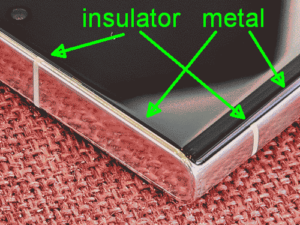
If you look closely at your mobile phone, you will see that most of its four edges are made of metal. But if you look closely around the four edges, will also see at least three narrow lines that are not metal — those lines are insulators. The point of this blog article is that it is a mistake to fail to pay attention to these insulators.
The way that a mobile phone does its job is by communicating with a cell tower. The communication is by transmitting and receiving radio signals. The only way to transmit or receive a radio signal is by means of an antenna.
Which raises the natural question — on your mobile phone, where is the antenna?
And the answer is, the metal edges of your mobile phone are the antenna.
Which now brings us to the insulators. You can do an experiment. Look to see how many bars of signal your phone is reporting. Moisten your fingertips, and touch a moistened fingertip to each of the insulators around the four edges of your mobile phone, so that you provide a conduction path across each of the insulators. While keeping your fingertips in place, look again to see how many bars of signal your phone is reporting. I predict that you will see fewer bars of signal. If you moisten your fingertips with salty water, you might be able to reach a “no signal” situation.
The alert reader will have no difficulty figuring out where I am going with this. The mistake to avoid with your mobile phone is to avoid allowing your hand, especially a moist hand, to provide conduction paths across any of the insulators.
If you use a phone case, then you probably never need to think about this. The phone case probably prevents your skin from touching any of the metal edges.

Some mobile phones have antennas on their edges, as Carl described. However, other mobile phones have antennas elsewhere, such as traces on printed circuit (PC) boards within the phone housing. See, for example this video (https://www.youtube.com/watch?v=5bjfkZ32lgg), which shows disassembly of a Samsung A13.